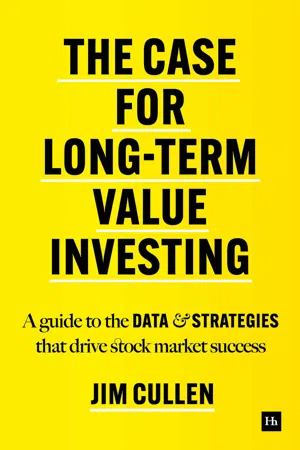
The Case for Long-Term Value Investing
A guide to the data and strategies that drive stock market success
- English
- ePUB (mobile friendly)
- Available on iOS & Android
The Case for Long-Term Value Investing
A guide to the data and strategies that drive stock market success
About this book
Value investing moves in and out of favour, but the data doesn't lie. It has always worked, and will continue to work — as long as investors apply a value discipline and invest for the long term.In The Case for Long-Term Value Investing, experienced Wall Street pro Jim Cullen presents the eye-opening data that backs this up, explaining how investors can use the value approach for successful investing today, as well as sharing a wealth of fascinating stories from his time on the Street.Discover: The true principles of value investingJim's stock-picking method in detailInspiring case studies of successful value investmentsHow to apply the value discipline through practical strategies. The Case for Long-Term Value Investing also includes a concise history of the last 100 years of market history — showing just how crazy the market can be — with a review of bear markets, recessions, bubbles, melt-ups, interest rates, and much, much more. The Case for Long-Term Value Investing is the ultimate introductory guide to how and why value investing works, how to understand the markets, and how to be a successful investor.
Frequently asked questions
- Essential is ideal for learners and professionals who enjoy exploring a wide range of subjects. Access the Essential Library with 800,000+ trusted titles and best-sellers across business, personal growth, and the humanities. Includes unlimited reading time and Standard Read Aloud voice.
- Complete: Perfect for advanced learners and researchers needing full, unrestricted access. Unlock 1.4M+ books across hundreds of subjects, including academic and specialized titles. The Complete Plan also includes advanced features like Premium Read Aloud and Research Assistant.
Please note we cannot support devices running on iOS 13 and Android 7 or earlier. Learn more about using the app.
Information

Table of contents
- Contents
- The Case For long-term Value Investing
- Background
- About the Book
- Section One: The Battle
- Section Two: The Value Strategy
- Section Three: Market Timing
- Section Four: Picking the Stocks
- Section Five: Applying The Strategy
- Section Six: The Market
- Getting Started: New Investors
- Final Note
- Appendix: Calculation Methodology for Chapter 2 Study
- Acknowledgments
- Publishing details